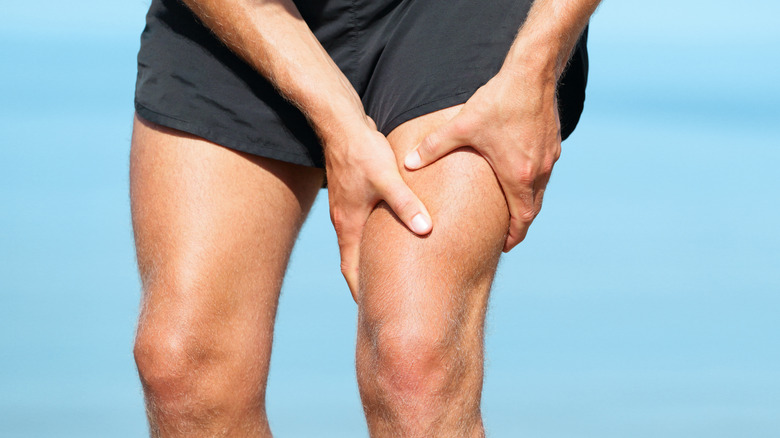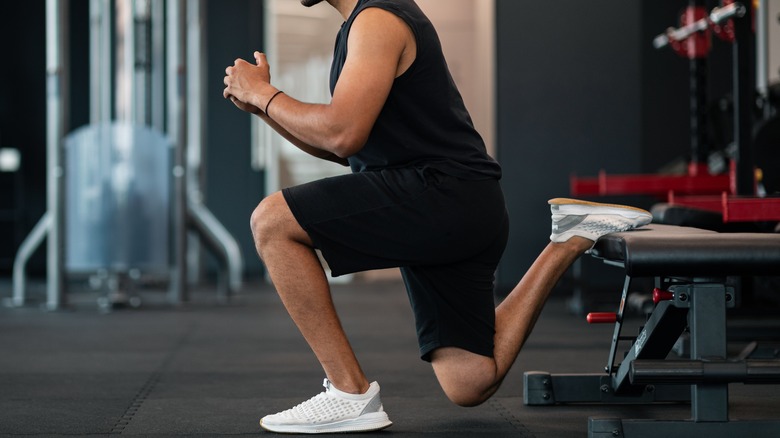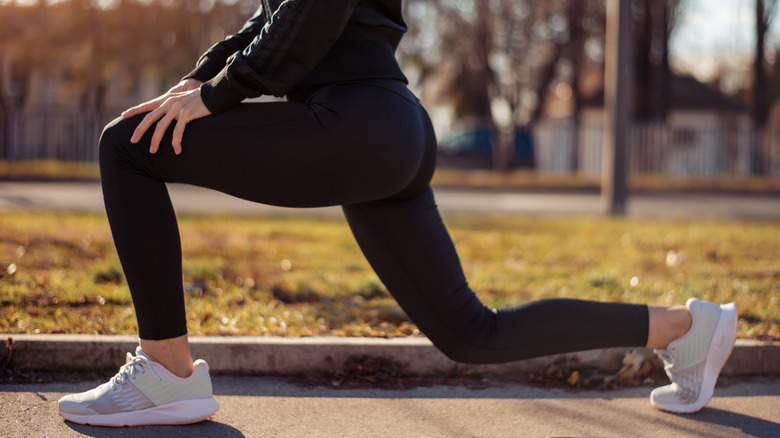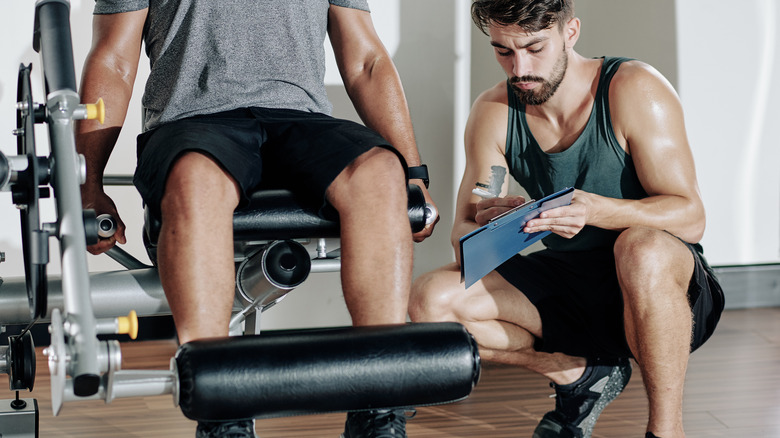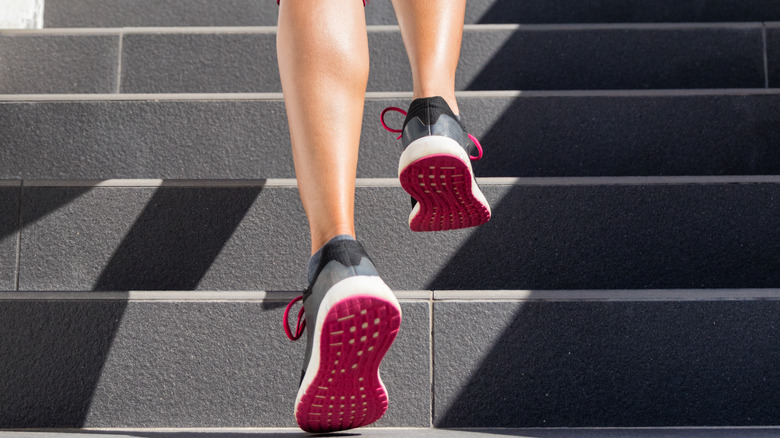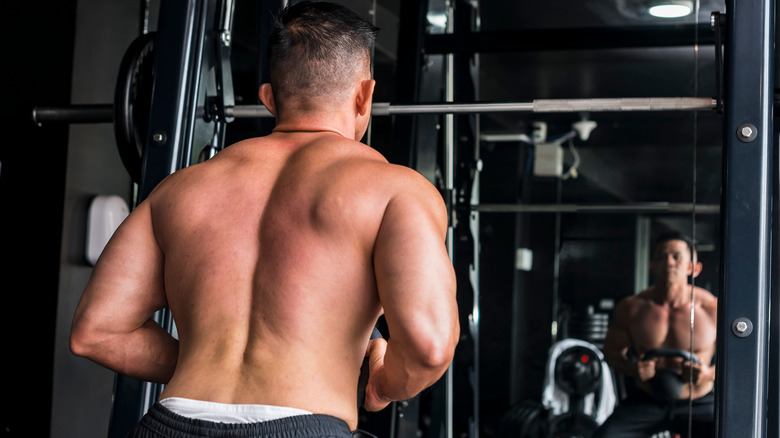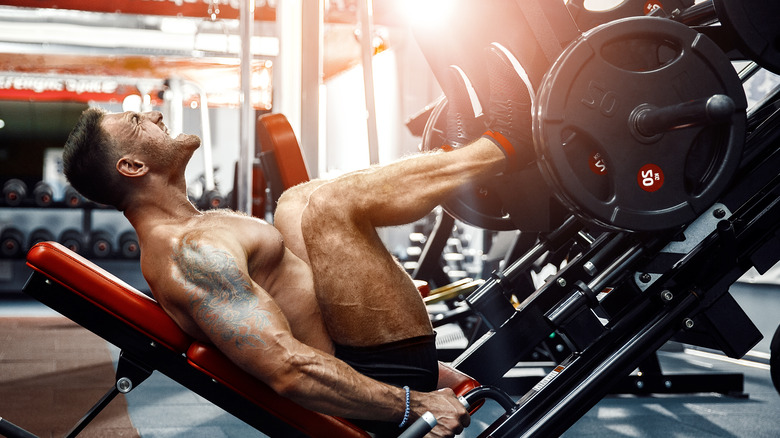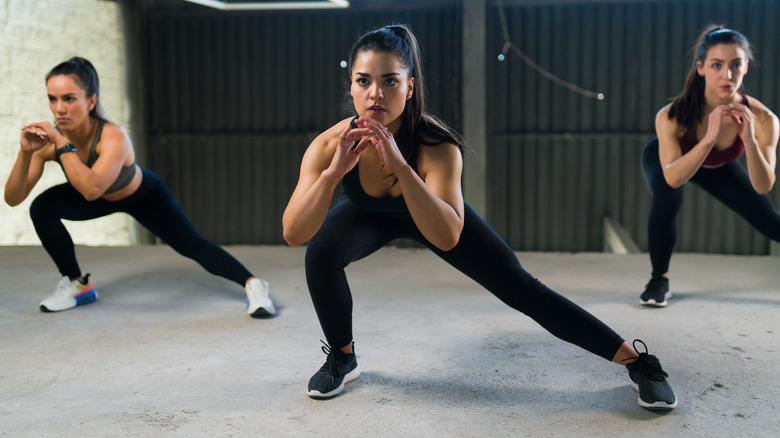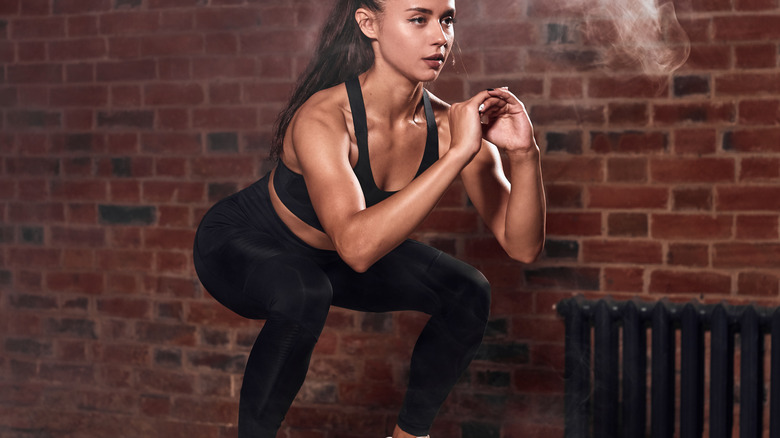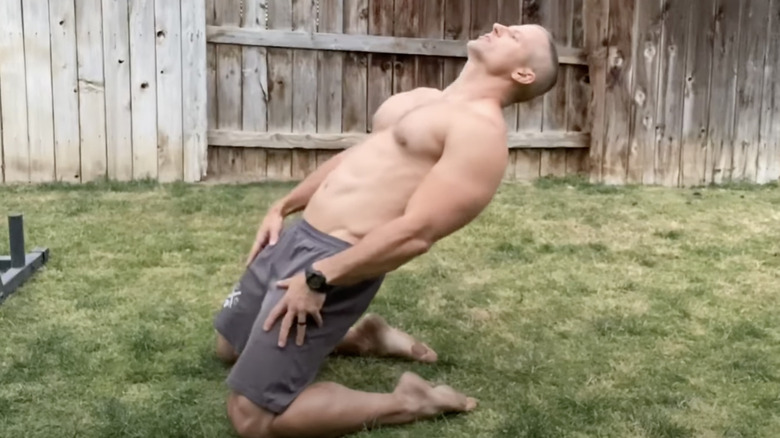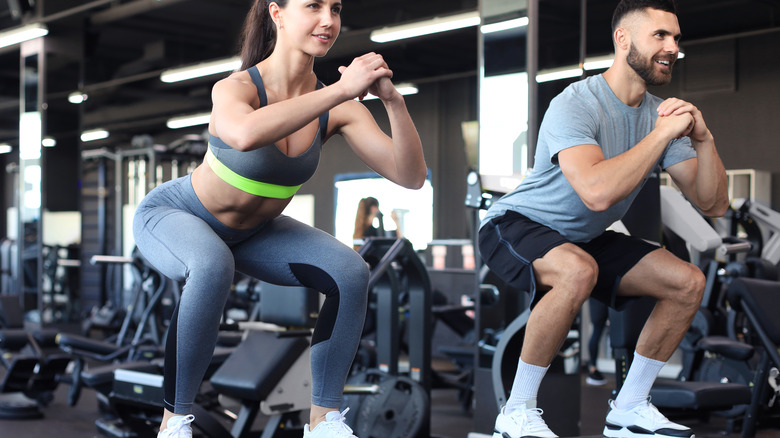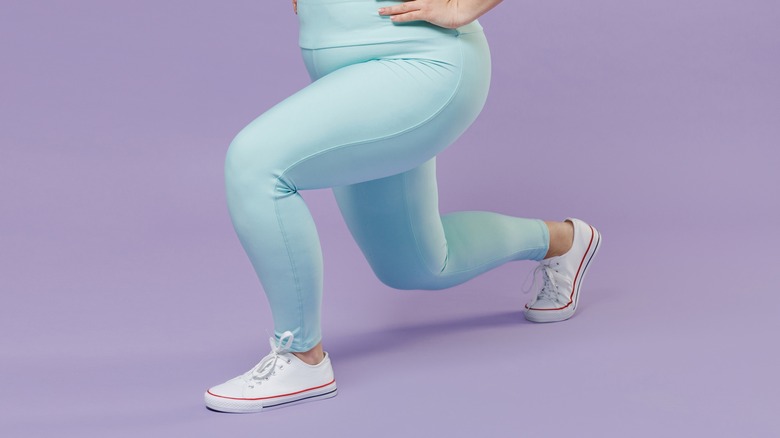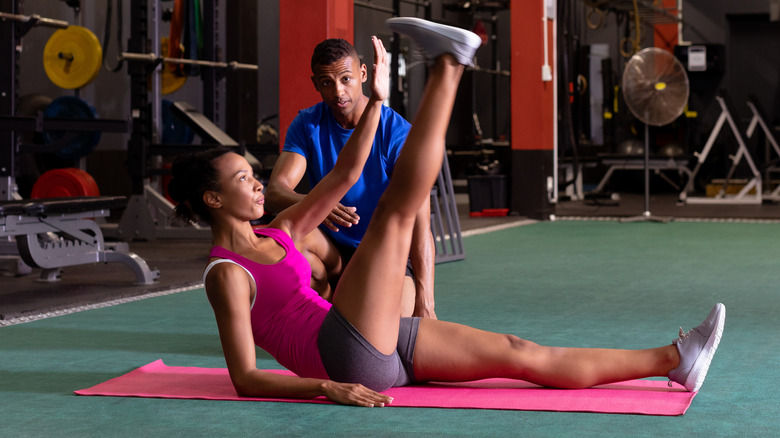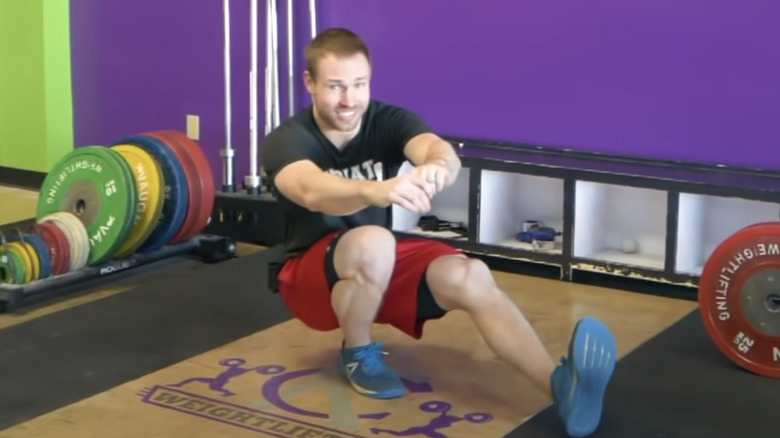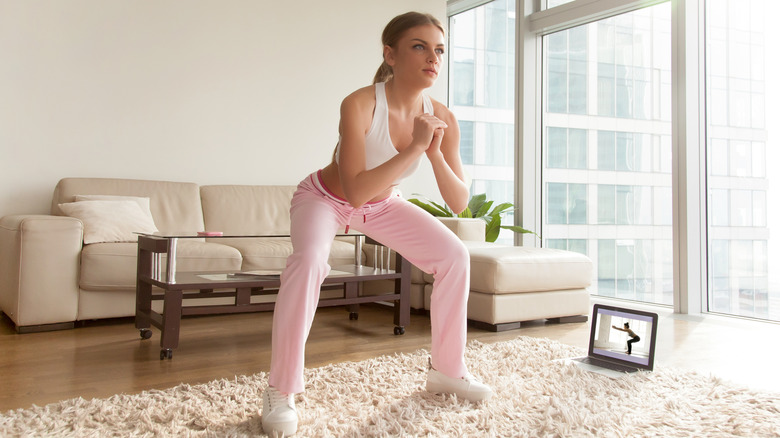14 Workout Moves That Target Your Quads
Whether you know it or not, it's likely that somewhere deep inside you, you desire strong quads. Quads that will propel you over miles of track, quads that will have you leaping higher than any human has ever leaped before. Sounds good, doesn't it? The quads — the five muscles that sit on the front of your thigh, with a slightly misleading name (thanks to physicians previously assuming there were four of them) — are used in pretty much every major movement our body does, from walking to kicking (per the Cleveland Clinic). As such, keeping them well-tended is essential, not only to ensure that you're able to complete your daily functions with ease and exercise effectively, but also to prevent injury.
But how exactly do we target these muscles efficiently? The good news is that there are a host of exercises out there that can leave you with the rippling quads you know you crave — and some of them are so easy to execute, you'll be wondering why you've never done them before. So stretch out those muscles, and let's take a look.
Bulgarian split squats
Doing the Bulgarian split squat is not only an excellent way to feel a little more European while you're working out, but it's also a highly effective move to target your quads, says Well+Good. And not only that, but the Bulgarian split squat will serve to target all of the other major muscles in your lower body, and more besides. "You're not only working on strength, but also on balance, stability and mobility," says The FitNest trainer and kinesiologist Zehra Allibhai. We love a workout move that shows up for everything you need!
Begin by standing in front of a chair or exercise bench with your back to it, then take a step out. Lift one of your legs and place the top side of it flat on the surface behind you. Make sure that your feet are shoulder-width apart, and then lean your torso forward slightly. Then, squat your front leg down, utilizing your back foot to keep you stable, and after pausing briefly at the bottom, drive back up through your front leg to your standing position. Aim for around twelve reps, three sets on each side, as a starting point.
Walking lunge
Honestly, it doesn't get more simple than this. Lunges of all variations are in workout plans around the globe, but the walking lunge is where it all began — and your quads will thank you for adding this to your routine.
The walking lunge will blast the muscles on the front of your thigh, as well as your glutes, calves, and hamstrings, for a full lower-body workout, Coach says. And in addition, your core will also feel the burn, thanks to the constant forward motion you'll be doing as you step from lunge to lunge.
The main thing you need to do this move is space. In an open area or a long, narrow passage like a hallway, stand with your feet shoulder-width apart, your body upright. Then, lift one of your feet, and step it forward, into a lunge position. Lower yourself into a lunge, and hold there briefly, before using your back leg to push yourself forward and back up. Before your leg settles next to the other, though, immediately step into another lunge with the other leg. The more that you keep the motion moving, the more of a workout you'll get, especially in your core, which has to constantly fight to keep your body upright.
Leg extensions
While it's easy enough to get a premium workout for your legs without using any gym equipment, now and again you might find that a little assistance can help. Enter the leg extension machine. These machines are an excellent way to target just your quads, which is super useful if you're trying to gain size or strength in that area specifically (per PureGym). Isolating your quads may also help if you've been training other parts of your legs more fervently, and now need your quads to catch up.
Start by adjusting the machine so you're able to sit in it comfortably. Your knees should be bent to 90 degrees, and your hands should be able to grip the sides of the machine lightly and comfortably. With your legs under the weight pad, engage your quads, and push the pad up so that your legs are straight. Squeeze your quads at the top of the movement, and then gradually lower them back down. You may need to experiment with weight slightly before you get it just right for your purposes.
Beware, though: If you have weak knees or ACL or ligament injuries, you're better off staying away from this machine, as you could seriously injure yourself.
Step-ups
Sometimes, it's as simple as stepping up, then stepping down. Step-ups are a deceptively simple move, but they're also one of the best ways to engage and build your quad strength, according to the Mayo Clinic. The step-up will also get your glutes and hamstrings working, and the best thing about this move is that it's so easy, literally anyone can do it, and you can adapt it to your fitness and workout needs however you choose to.
To start, grab yourself a step or a box (you can also do this on the lowest step of your staircase), and stand in front of it, with your feet hip-width apart. Using your right foot, step up onto the step in front of you, bringing your left foot up to meet it. Then, use your right foot to step backward and down, again bringing the other foot down, to the starting position. Alternate with the opposite foot, for as many reps as you require. While this move is as easy as they come, it's really important not to let your posture or form flag while you're doing it: Make sure that your core's engaged, and that your back remains upright throughout.
Goblet squats
With the proliferation of fantasy TV shows coming out these days, this is a move named for all those who wish they could be swigging mead next to a troll after fighting a dragon. Okay, we digress. But the goblet squat, despite having a pretty fantasy-esque name, is also a supreme move for your quads, as well as your glutes, your core, and your upper back muscles from holding the weight in place (per the NASM).
To do this move, you'll need a dumbbell or kettlebell to hand. Hold it in front of your chest, with one hand on each side, and place your feet hip-width apart. Make sure you have engagement throughout your upper body, then gently move down into a squatting position, with your butt being sent back. Ensure that your chest doesn't bend forward (which can happen due to the weight of the dumbbell or kettlebell) — it should remain upright and facing forward as your body moves downward. At the bottom of the squat, pause briefly, and then use your heels to drive yourself back up to your standing position.
Leg press
Sometimes, you just need to go big on your legs. And that's where the leg press machine comes in. That piece of equipment in the gym that looks somewhat like a Medieval torture device, the leg press is one of the best things you can be using to build up your quads, according to Livestrong. Your hamstrings and glutes will also get involved, while removing any strain on your upper body.
While using the leg press machine looks simple, there are a few key mistakes to watch out for that could hamper your workout. Make sure that you're not bending your legs too extremely, or that your reps aren't too shallow (via Bodybuilding.com). You need to try and ensure that your knees are bending to around a 90-degree angle each time. Importantly, too, you should avoid locking your knees at the top of each rep, as this can not only reduce the pressure on your legs (therefore inhibiting your workout), but also potentially damage your knee joints. Maintain a slight bend in your knees when you're at the top of the movement.
Lateral lunge
Picture this: A group of marketing executives, standing around a board Mad Men-style, trying to figure out how to make the lunge cool again. One of them has a brainwave. They take the picture of the person lunging, and turn it to ... the side. The room erupts in applause. Fireworks go off outside the window.
Okay, so that's probably not how the lateral lunge (or side lunge) came to be, but if you haven't done one, your quads are missing out. Not only that, but "the side lunge is a great exercise because it works the sides of the glutes (the gluteus medius), which are important stabilizer muscles for the hip joint, and are often under-appreciated," says trainer Rachel Mariotti (via Shape).
Start with your feet hip-width apart, and your hands held together in front of your chest. Then, step one of your feet out and to the side, moving into a lunging position, with your knee moving over your foot. After holding the lunging position at the bottom briefly, use the same leg to push yourself back up to a standing position and the anchoring foot. Repeat for 8 to 12 reps before switching sides to work on the other leg.
Box jump
When was the last time you just jumped around? Probably when you were a kid, right? Well, folks, here's your permission to do so, and to justify it by knowing that jumping exercises like box jumps can seriously benefit your quads, according to Coach Magazine. This plyometric exercise won't just hit your quads, too: As most full lower-body exercises tend to do, box jumps will also target your hamstrings, calves, and glutes.
Box jumps look simple, but they can be deceptively difficult to get right. To start, get yourself a sturdy box, which will take your weight jumping on it — a higher box will help you develop more muscular strength, while a shorter box will give you more of a cardio workout, says personal trainer Joe Spraggan. Stand with the box in front of you, with your feet spread hip-width apart, and then lower yourself into a quarter-squat. Using your arms to deliver momentum, leap off the ground with both feet, and land as softly as possible on top of the box. Try to keep your form and not crunch yourself into a ball too much when you land on the box, which can indicate that your box is a little too tall. Step back down or leap down gently, and repeat for three to five reps.
Kneeling leg extension
Say the words "leg extension" to someone, and they'll probably immediately picture grunting and sweating on a machine at the gym. But leg extension exercises can be performed easily at home, without equipment, and kneeling leg extensions are just the way to do it (per SELF). Kneeling leg extensions offer a premium way to work your quads when you're feeling just a little bored of squats and lunges, and the movement of the exercise isolates the muscles on the front of your thigh.
Begin by kneeling on the floor, with your upper body straight. Your knees should be placed a regular distance apart, with your core and legs activated and your chest upright. With your hands resting on your sides, gradually lean your upper body and thighs back, ensuring that your back doesn't arch or round as you do so. When your glutes are almost about to touch your heels, hold the position briefly, and then pull your body back up to the beginning position, engaging your quads as you do so. Repeat for as many reps as you like.
Squat jumps
Look, we know. It's always a moment of pure terror when the squat jumps (or squat jumps) roll around on your workout video. But whether you hate them or ... Hate them, there's no denying that squat jumps are pretty amazing for your quads, as well as all of the other major muscles in your lower body (per Healthline). In addition to that, the intensity of the movement gives your heart a workout, too — though it's important to mention that as a high-impact activity, performing squat jumps can put pressure on your joints.
Begin in a standing position, and move your feet to a position that's slightly wider than you're used to, which will help stabilize you when you land from the jump. Come down into a regular squat, then jump up from the squatting position into the sky, landing gently on the floor. Repeat at your chosen speed, for however many reps you desire. If you're moving at a swift pace, it's important to keep your form steady. Make sure that your back isn't rounding or that you're not bending forward too much, and keep your core muscles engaged to add stability to the movement. You can mix up your squat depth, too. "Deeper squats recruit more muscles, but shallow or quarter-squat depth allows for more athletic explosiveness and more efficient jumping," says certified strength and conditioning specialist Chris Ryan (per Women's Health Magazine).
Reverse lunge
Sometimes, in life, you have to move backward. And that's not always a bad thing, especially when you're exercising. "The reverse lunge is probably the best overall single-leg exercise you can do," says certified strength and conditioning specialist Darin Hulslander (via Women's Health Magazine). Reverse lunges are a brilliant way to hit your quads hard, as well as a host of other lower-body muscles. Plus, they can also improve your stability and the flexibility in your hips and knees, and create more uniformity in your muscle strength.
Begin by standing upright, with your feet a regular distance apart. You can do this move by just using your body weight, or by adding a kettlebell or a pair of dumbbells, which you can hold in front of you or by your sides. Adding weights will make this more of a muscle-strengthening exercise. Lift one of your feet, and then step back into a lunging position, allowing your back knee to come down towards the ground. Your front knee should be at a 90-degree angle at the lowest point of your lunge. Then, using your back foot, push yourself back up into your starting position, before repeating the movement with the opposite leg.
Single-leg raise
Most quad exercises work on all the muscles in your quadriceps at the same time, but sometimes, it can be helpful to get a little more specific. That's exactly what a single-leg raise can provide, as Healthline discusses. Single-leg raises target your rectus femoris, the larger muscle that travels from the front of your hip down to your knee and helps to give your quads their unique shape (per Kenhub). Additionally, it can also provide strengthening benefits to your core and your hip flexors.
Begin on the floor, lying on your back, with one leg outstretched (keeping a slight bend in your knee) and your other leg bent to a 90-degree angle and planted on the floor. Make sure that your core is engaged, and then, slowly lift your straightened leg off the ground until your thigh becomes parallel with your bent leg. Hold your leg there briefly, and then slowly lower it down, allowing it to lightly touch the ground before you repeat the exercise. Continue for as many reps as you require, and then repeat using the other leg.
Pistol squat
Okay, people, it's time to get serious. Let's talk about pistol squats. Pistol squats may be one of the hardest squat variations out there, but boy, are they worth it. By incorporating pistol squats into your workouts, your quads will be blasted like nothing else, as well as your other leg muscles. And given that you're having to do these squats on one leg at a time, your balance will also be seriously tested (per Men's Health).
To do pistol squats, however, you're going to have to build up to them. Begin by making sure that your joints and muscles are all warmed up and feeling mobile — if you have any difficulties moving your ankles, hips, or knees, avoid pistol squats, which will place a huge amount of pressure on your leg joints. Then, focus on nailing your air squat form, before moving to close-feet squats. You can then move on to single-leg squats, followed by single-leg box squats, toe squats, and finally, floater squats. Only when those are all mastered should you move onto a pistol squat, performed by lifting one leg up and forward (like a pistol's barrel), and using the other leg to squat down, using your arms extended outward to stabilize you (per Runner's World).
Sumo squats
Let's spread out. When regular squats start to get a little boring, the sumo squat can provide a worthwhile alternative. "The sumo squat is a great lower-body strength exercise that emphasizes the muscles of the inner thigh, as well as the glutes, quads, hamstrings, hip flexors, and calves," according to FITURE head instructor Lisa Niren (via Shape). Thanks to the change in form that a sumo squat provides, your core may see some extra engagement, too. You can also make the exercise more difficult (and more effective) by adding weights into the mix, or even placing a resistance band around your thighs.
Stand with your feet placed in a wide stance, with your toes angled slightly outward. Then, while avoiding letting your hips move forward, come down into a squat. Make sure that your knees are moving over your feet and that your back isn't rounding forward as your thighs become parallel with the floor. After pausing briefly at the bottom of the squat, drive through your heels to come up to a standing position. Repeat for up to 15 reps, before pausing before the next set.

